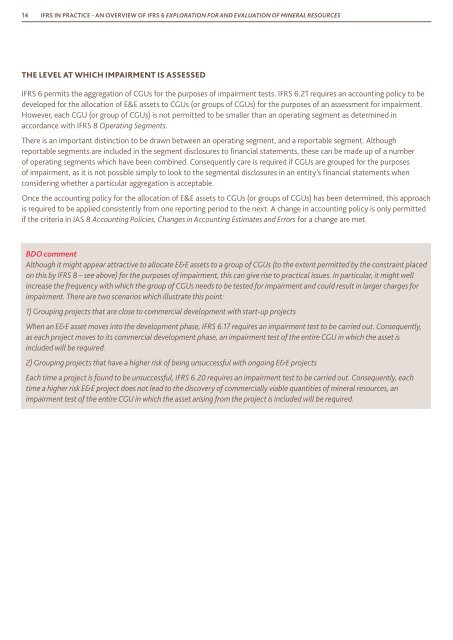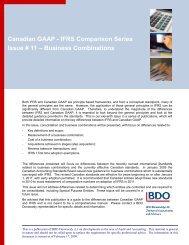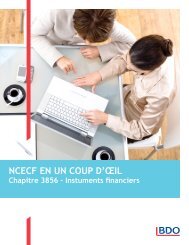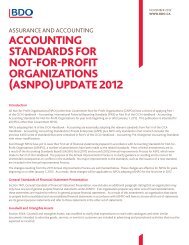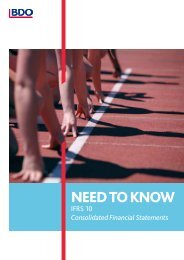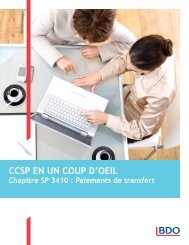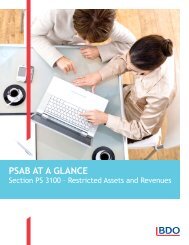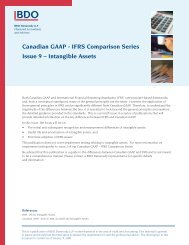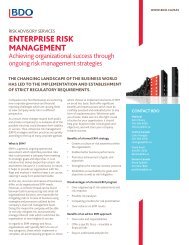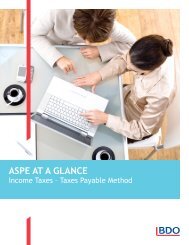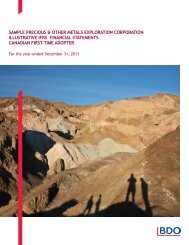IFRS 6 Exploration For and Evaluation of ... - BDO International
IFRS 6 Exploration For and Evaluation of ... - BDO International
IFRS 6 Exploration For and Evaluation of ... - BDO International
- No tags were found...
Create successful ePaper yourself
Turn your PDF publications into a flip-book with our unique Google optimized e-Paper software.
14 <strong>IFRS</strong> IN PRACTICE - AN OVERVIEW OF <strong>IFRS</strong> 6 EXPLORATION FOR AND EVALUATION OF MINERAL RESOURCESTHE LEVEL AT WHICH IMPAIRMENT IS ASSESSED<strong>IFRS</strong> 6 permits the aggregation <strong>of</strong> CGUs for the purposes <strong>of</strong> impairment tests. <strong>IFRS</strong> 6.21 requires an accounting policy to bedeveloped for the allocation <strong>of</strong> E&E assets to CGUs (or groups <strong>of</strong> CGUs) for the purposes <strong>of</strong> an assessment for impairment.However, each CGU (or group <strong>of</strong> CGUs) is not permitted to be smaller than an operating segment as determined inaccordance with <strong>IFRS</strong> 8 Operating Segments.There is an important distinction to be drawn between an operating segment, <strong>and</strong> a reportable segment. Althoughreportable segments are included in the segment disclosures to financial statements, these can be made up <strong>of</strong> a number<strong>of</strong> operating segments which have been combined. Consequently care is required if CGUs are grouped for the purposes<strong>of</strong> impairment, as it is not possible simply to look to the segmental disclosures in an entity’s financial statements whenconsidering whether a particular aggregation is acceptable.Once the accounting policy for the allocation <strong>of</strong> E&E assets to CGUs (or groups <strong>of</strong> CGUs) has been determined, this approachis required to be applied consistently from one reporting period to the next. A change in accounting policy is only permittedif the criteria in IAS 8 Accounting Policies, Changes in Accounting Estimates <strong>and</strong> Errors for a change are met.<strong>BDO</strong> commentAlthough it might appear attractive to allocate E&E assets to a group <strong>of</strong> CGUs (to the extent permitted by the constraint placedon this by <strong>IFRS</strong> 8 – see above) for the purposes <strong>of</strong> impairment, this can give rise to practical issues. In particular, it might wellincrease the frequency with which the group <strong>of</strong> CGUs needs to be tested for impairment <strong>and</strong> could result in larger charges forimpairment. There are two scenarios which illustrate this point:1) Grouping projects that are close to commercial development with start-up projectsWhen an E&E asset moves into the development phase, <strong>IFRS</strong> 6.17 requires an impairment test to be carried out. Consequently,as each project moves to its commercial development phase, an impairment test <strong>of</strong> the entire CGU in which the asset isincluded will be required.2) Grouping projects that have a higher risk <strong>of</strong> being unsuccessful with ongoing E&E projectsEach time a project is found to be unsuccessful, <strong>IFRS</strong> 6.20 requires an impairment test to be carried out. Consequently, eachtime a higher risk E&E project does not lead to the discovery <strong>of</strong> commercially viable quantities <strong>of</strong> mineral resources, animpairment test <strong>of</strong> the entire CGU in which the asset arising from the project is included will be required.


